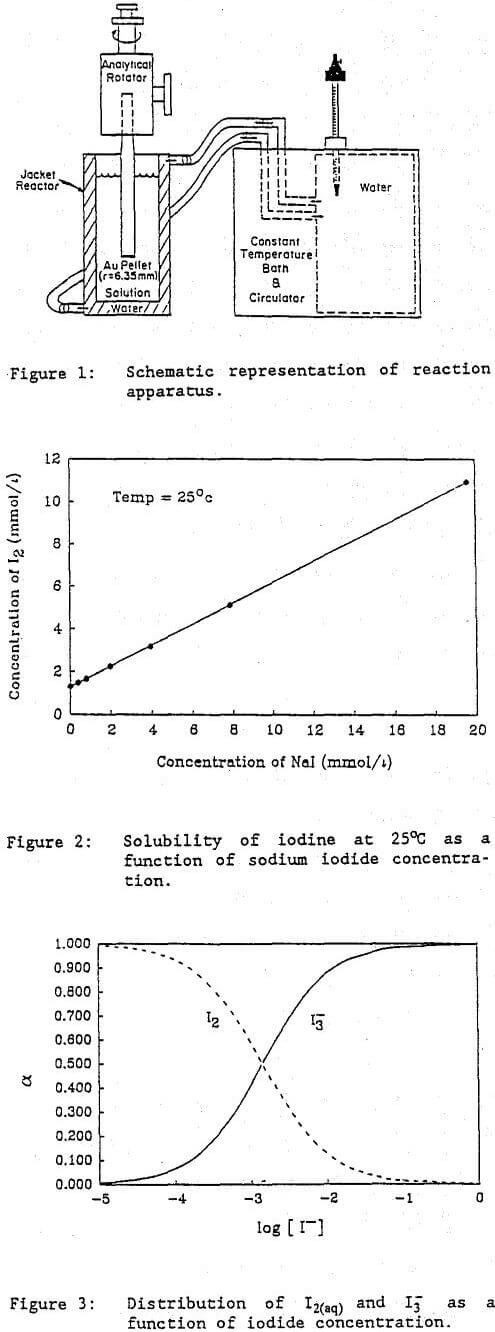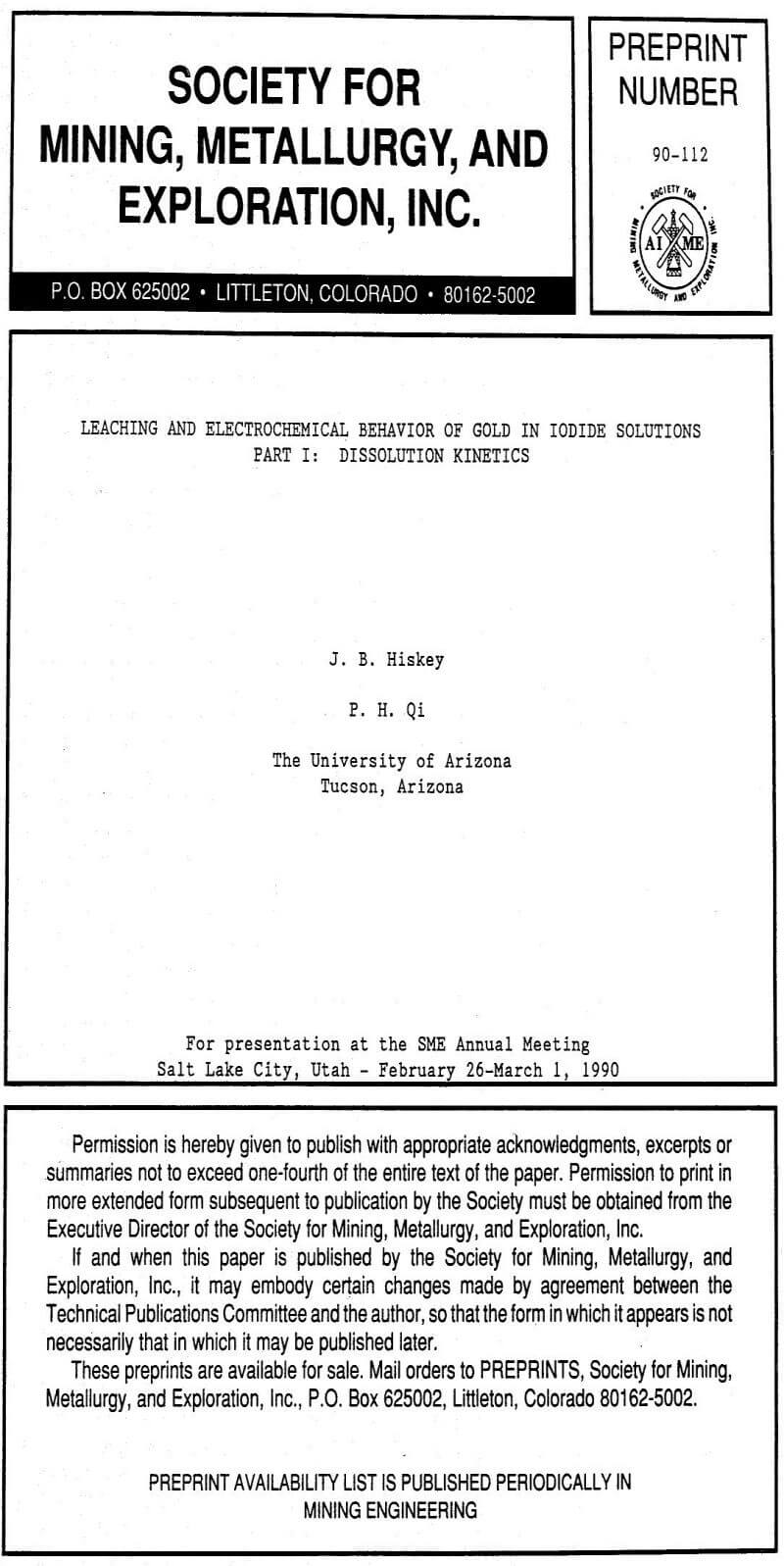 Over the last few years there has been an intense effort to identify lixiviants other than cyanide for gold and silver leaching. Bromide and iodide also exhibit the ability to form polyhalide complexes. This characteristic promotes the dissolution of Br2(s) and I(2)s in aqueous solution. Iodine reacts with iodide ion as follows:
Over the last few years there has been an intense effort to identify lixiviants other than cyanide for gold and silver leaching. Bromide and iodide also exhibit the ability to form polyhalide complexes. This characteristic promotes the dissolution of Br2(s) and I(2)s in aqueous solution. Iodine reacts with iodide ion as follows:
I(2)s = I2(aq)………………………………………………………..(1)
I2(aq)+ I- = I3-…………………………………………………….(2)
The triiodide ion can serve as an oxidant for gold leaching according to the following electrochemical reaction:
Au + 2I- → AuI2- + e- anodic……………………………………………………..(3)
I3- + 2e- → 3I- cathodic……………………………………………………………(4)
2Au + I- + I3- → 2AuI2- overall…………………………………………………(5)
McGrew proposed the use of an I- containing electrolyte to leach gold ores. An iodine lixiviant is added to an ore containing iodine reducing components. As iodide ion increases in the lixiviant, it is possible with continued addition of iodide to achieve the desired concentration for leaching gold. This is made possible by the complexation of I2 with I- to form the polyiodide species. They report that the initial solubility of iodine is about 1..2 x 10 -3 M and that the desired concentration of about 1.2 x 10 -2 M could be attained by solution recycle. In a column experiment, 80% of the gold in a marcasite ore was recovered by iodine leaching. It should be noted that gold did not start to dissolve until a sufficient concentration of iodine species remained in solution.
The fundamental kinetics of iodide leaching of gold have been examined by using a rotating disk technique and are reported in this paper. The most important kinetic parameters have been identified and a rate expression is proposed. Electrochemical measurements for the gold in different halides with special emphasis on iodide will be presented in Part II of this study.
The experimental method employed for the leaching tests utilized the rotating disk technique. Two grams of gold high purity powder which was obtained and used to make the gold disk. The flat disk was formed in a 1.27 cm diameter pressure mold at a total pressure of 20,000 pounds per square inch. The calculated density of pellet was approximately 17.6 g/cm³ compared with the theoretical density for gold of 19.3 g/cm³. The disk was then sealed in a Teflon holder which could be screwed on the Analytical Rotator (Model ASR2 of Pine Instrument Co.) so that only one surface of the disk was exposed to solution.
The surface of gold disk was carefully polished on 600-grit silicon carbide paper and thoroughly rinsed prior to each test. All chemicals used in this research were of reagent-grade quality. Distilled-deionized water was used to prepare the required leaching solution. Pure oxygen was used in the test requiring oxygen sparging.
To study the effect of temperature effect, a constant temperature water bath/circulator was employed which circulated water through a jacketed reaction flask.
Leaching reaction was carried out in a 500-ml round-bottom reaction flask with three angled necks. Samples were withdrawn at regular intervals for analysis. These samples were analyzed using a Perkin-Elmer (model 273) Atomic Absorption Spectrophotometer.
The leaching experiments were carried out under the following conditions, which were maintained constant except for the studied or indicated parameters:
- Solution: 1 x 10 -2 M NaI & 5 x 10 -3M I2
- Temperature: room temperature (23 °C)
- Rotating Speed: 500 rpm
- Time: 6 hours
- pH: 4-6 (natural pH)
The schematic diagram of the reaction apparatus is presented in Figure 1.
The rate controlling step for the dissolution of gold in iodide solution is postulated to involve a mixed kinetic regime similar to that involved in the cyanidation of gold and silver. Gold dissolution rate follows a linear relationship with the square root of the disk rotation speed which may indicate that diffusion of reactants through the liquid boundary layer to the gold surface may control the rate. However, by the observation alone it is not possible to eliminate mixed kinetics (i.e. diffusion plus charge transfer) from being rate controlling.
- Gold dissolution in the presence of iodide using iodine as an oxidant proceeds by the following reaction:
2Au + I- + I3- = 2AuI2- - Dissolution of gold in I-/I2 solutions follows the first order kinetics.
- The first order rate is proportional to square root of the disk rotation speed.
- The reaction is first order with respect to the triiodide complex and half-order with respect to iodide.
- Oxidants such as oxygen and hydrogen peroxide have almost no effect on the gold dissolution with iodide.
- Gold dissolution is insensitive to the presence of Na2SO4 and NaCl and is also insensitive to pH over the range pH 2 to 10.
- Of the halogens, iodide has the strongest capability of dissolving gold in aqueous solutions. Its dissolution rate has the same level comparing with that of gold cyanide system.
- At low I2 concentrations, the experimental activation energy was determined to be 15.2 kJ/mol. While at higher I2 concentrations, a value of 23.5 kJ/mol was obtained for the leaching reaction.

